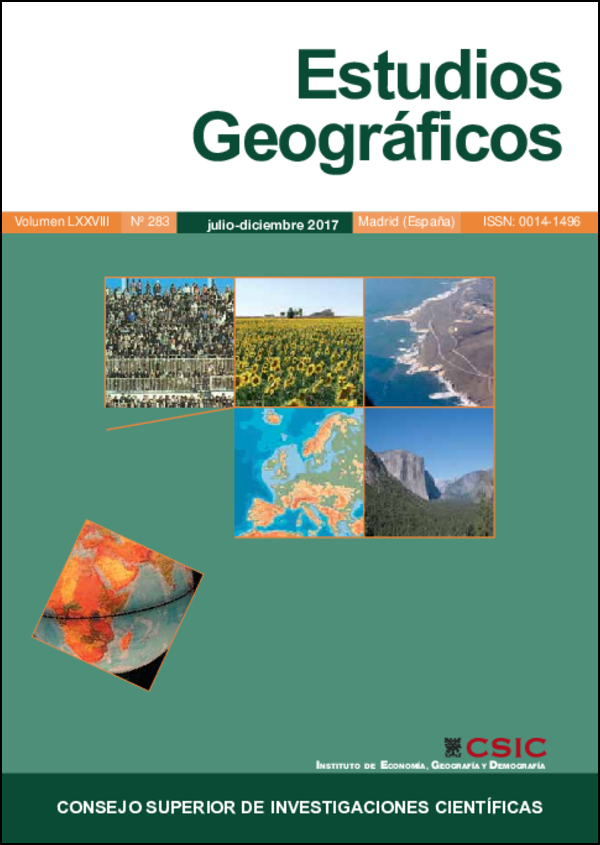Convection breeze in Tenerife
DOI:
https://doi.org/10.3989/estgeogr.201713Keywords:
breeze source, convection, Tenerife, Canary IslandsAbstract
The sea breeze front is a mesoscale phenomenon of great importance in meteorology and climatology as storms trigger mechanism under atmospheric instability. If the breeze front also interacts with other areas of convergence, the additional vertical movement that occurs in these areas of intersection greatly increases the probabiility of convective activity and developement of more severe storms. This paper aims to conduct a study on convective episodes in the southern slope and/or east of the Tenerife island, associated with daytime heating and forced by the breeze front and/or convergence downwind surface synoptic flow in 2005, 2009 and 2012, ffrom the meteorological characterization of 4 outstanding and representative situations. The purpose, therefore, is to characterize the convection which is generated at the interior of the island of Tenerife that mainly affects medium and high areas.
Downloads
References
Azorín, Molina C. (2002): «La formación de frentes de brisa activos en la comarca alicantina del Alto Vinalopó. El episodio atmosférico de 27 de abril de 2001». Investigaciones Geográficas, nº 29, pp. 109-130 https://doi.org/10.14198/INGEO2002.29.01
Cano, D., B. Téllez, I. Palacio y P. Arias (2001): «Estudio de las zonas más favorables para el desarrollo de tormentas en la Meseta meridional». El Tiempo del Clima, AEC, pp. 313-324
Cuadrat, J., Pita, F, Mª (2000): Climatología, Cátedra, Madrid.
Doswell, C. A. III, Harold E. Brooks, y Robert A. Maddox (1996). «Flash Flood Forecasting: An Ingredients-Based Methodology». Wea. Forecasting, 11, pp. 560-581. https://doi.org/10.1175/1520-0434(1996)011<0560:FFFAIB>2.0.CO;2
González Márquez, J. y Heredia, M.A. (2001): «Convección por brisa en Mallorca». V Simposio nacional de predicción del Instituto Nacional de Meteorología, Ministerio de Medio Ambiente, Madrid, pp. 1-6.
Lyons. W.A. (1972): «The climatology and prediction of the Chicago lake breeze». J. Appl. Meteor., 11, (1259-1270). https://doi.org/10.1175/1520-0450(1972)011<1259:TCAPOT>2.0.CO;2
Martín, F, Elizaga, F, Carretero, O. San Ambrosio, I. (2007): Diagnóstico y Predicción de la Convección Profunda. Nota Técnica Nº 35 del STAP. Aemet.
Olcina, J. Miró, J (1998): «Influencia de las circulaciones estivales de brisa en el desarrollo de tormentas convectivas». Papeles de Geografía, nº 28, 109-132.
Romero Ruiz, C. (1986): «Aproximación a la sistemática de las estructuras volcánicas complejas de las islas canarias». Eria, 11, pp. 211-224.
Sanz Moral, M.P, Arteche García J. L, Ortiz Berenguer F. J. (2004): «Climatología de tormentas veraniegas». El Tiempo del Clima (AEC), Servicio de Publicaciones de la Universidad de Cantabria, 754 pp. Serie A, nº 4.
Stull, Roland B. (1988): An Introduction to Boundary Layer Meteorology. Kluwer Academic Publishers. Boston. www.wetterzentrale.de http://weather.uwyo.edu/upperair/naconf.html https://doi.org/10.1007/978-94-009-3027-8
Downloads
Published
How to Cite
Issue
Section
License
Copyright (c) 2018 Consejo Superior de Investigaciones Científicas (CSIC)

This work is licensed under a Creative Commons Attribution 4.0 International License.
© CSIC. Manuscripts published in both the print and online versions of this journal are the property of the Consejo Superior de Investigaciones Científicas, and quoting this source is a requirement for any partial or full reproduction.
All contents of this electronic edition, except where otherwise noted, are distributed under a Creative Commons Attribution 4.0 International (CC BY 4.0) licence. You may read the basic information and the legal text of the licence. The indication of the CC BY 4.0 licence must be expressly stated in this way when necessary.
Self-archiving in repositories, personal webpages or similar, of any version other than the final version of the work produced by the publisher, is not allowed.















